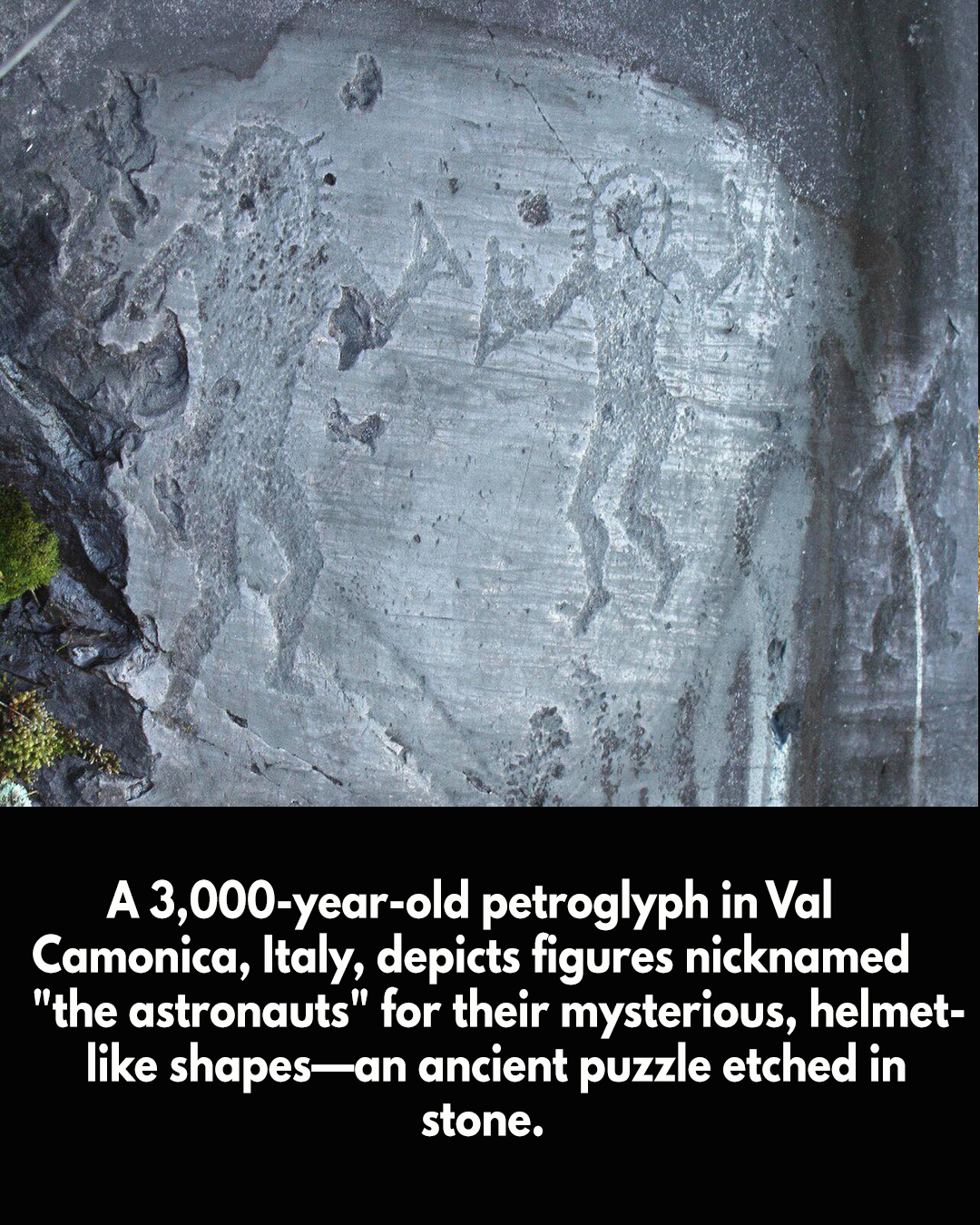
High in the mist-veiled mountains of northern Italy, where the wind hums through alpine trees and the rocks seem to hold their breath, lies a valley where time stands still. This is Val Camonica—a UNESCO World Heritage Site and home to one of the largest collections of prehistoric petroglyphs in the world. Over 140,000 figures have been carved into its ancient rock faces, forming a silent library of forgotten lives. But among them, a handful of carvings have stirred awe, skepticism, and fascination unlike any others: the so-called Camunian Astronauts.
They stand etched in stone—two humanoid figures with disproportionately large heads, radiating lines like halos or helmets, arms raised in a posture neither of worship nor surrender, but power. Their outline is hauntingly familiar to the modern eye: forms that echo the silhouette of space suits. For decades, these enigmatic carvings have sparked one burning question: were these depictions of gods, warriors, or something… not of this Earth?
The Valley of Forgotten Voices
The carvings of Val Camonica span over 8,000 years, from the Epipaleolithic era through to the Iron Age and the Roman conquest. These figures were painstakingly pecked into rock using stone tools, long before metal chisels existed. Most petroglyphs are earthly: hunters with bows, solar disks, farming scenes. They tell the story of a people deeply rooted in their environment—aware of the stars above, but not strangers to the soil beneath their feet.
And yet, around 3,000 years ago, something changed.
Two figures appear, unlike anything before or after. They are not animals or humans in motion. They are still. Monumental. Clothed in abstraction. They wear what look like helmets with rays or tubes sprouting from their heads, like sunbursts or antennae. In their hands, they hold tools or objects whose function is unknown. Their limbs are thick, their torsos oddly shaped—as if armored.
Who were they? What did they mean to the people who carved them?
Ancient Gods or Ancient Aliens?
Mainstream archaeologists suggest these figures may represent deities, shamanic beings, or masked ceremonial dancers. Some point to similarities with Bronze Age warrior figures, whose helmets bore elaborate crests. Others interpret the rays as symbolic auras—depictions of spiritual energy, not physical technology.
But for proponents of alternative archaeology—those who dare to venture into the realms of ancient astronauts and lost civilizations—this is a smoking gun. They argue that the figures resemble modern depictions of space travelers too closely to be coincidence. Could it be that these ancient people encountered visitors not of this world, or preserved a myth of sky-beings pᴀssed down for generations?
It is a bold hypothesis—one that challenges conventional timelines and our very understanding of human history.
But it is not without precedent.
Echoes Across the World
The Camunian Astronauts are not alone. Across the globe, similar figures appear in ancient art:
- In Tᴀssili n’Ajjer, Algeria, cave paintings depict humanoids with bulbous heads and antennae.
- In the Dogu figurines of Japan, mysterious eye-like goggles and strange suits wrap around clay bodies.
- In Mexico’s Palenque, a Mayan carving shows King Pakal seemingly piloting a spacecraft—or resting in a symbolic “World Tree.”
Are these universal archetypes—expressions of mythological power—or visual evidence of shared memories, encoded in stone and clay?
Or is it simply that we, the viewers, cannot help but see our own technology reflected back at us?
The Human Drive to Understand
Perhaps the most important truth about the Camunian Astronauts is not whether they depict aliens or gods, but what they say about us—about our need to search for connection across time. We look at these carvings not just with eyes, but with hope. Hope that we are not alone, hope that the past might still surprise us, hope that the mysteries of humanity have not yet all been solved.
We are pattern seekers. Story builders. And when we see ancient hands reaching out to tell us something, we lean in to listen.
In that quiet valley in northern Italy, the stones still speak. And they are asking questions we haven’t finished answering.
Final Reflection: The Puzzle That Endures
The Camunian Astronauts remain one of archaeology’s most debated images. For every scientist who calls them stylized warriors, there is a dreamer who calls them visitors from the stars. For every skeptic who sees a ceremonial mask, there’s a believer who sees a visor.
Perhaps the truth lies somewhere in between: not alien, not divine, but deeply human. A vision of power, mystery, and the unknown—born of minds unafraid to dream beyond the sky.
So next time you walk through Val Camonica, look closely.
What do you see in the stone?
#AncientAstronautTheory
#ValCamonicaMystery
#PrehistoricPuzzles
#PetroglyphSecrets
#AncientAliensDebunkedOrNot
#StoneMessages
#HistoryInStone
#CamunianAstronauts
#ArchaeoMystery
#EtchedInTime


